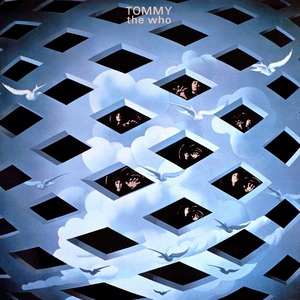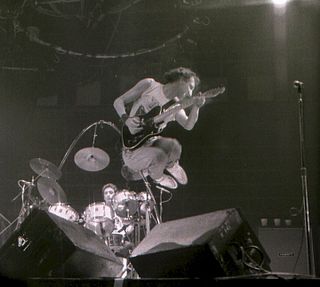Early years
In 1956, on the Lawrence Welk Show , a zoot-suited performer billed as "Rockin' Rocky Rockwell" did a mocking rendition of Elvis Presley's hit song "Hound Dog." At the conclusion of the song he smashed an acoustic guitar over his knee. [1] US country musician Ira Louvin was famous for smashing mandolins that he deemed out-of-tune. [2]

Jerry Lee Lewis may be the first rock artist to have destroyed his equipment on stage, with several, possibly erroneous, stories of him destroying and burning pianos in the 1950s. [3] Several contemporary musicians, including Annea Lockwood, Yōsuke Yamashita, and Diego Stocco, have incorporated piano burning in their compositions.
Jazz musician Charles Mingus, known for his fiery temper, reportedly smashed his $20,000 bass onstage in response to audience hecklers at New York's Five Spot. [4]
Nam June Paik's "One for Violin Solo", performed on 16 June 1962, featured Paik very slowly and intently lifting a violin, then smashing it with one blow on a table.
In London, 1966, a group of artists from around the world came together to participate in the first Destruction in Art Symposium (DIAS). According to the event's press release, the principal objective of DIAS was "to focus attention on the element of destruction in Happenings and other art forms, and to relate this destruction in society." Two events were scheduled to occur throughout London. During the course of the symposium, Raphael Montañez Ortiz performed a series of seven public destruction events, including his piano destruction concerts, which were filmed by both American Broadcasting Company and the BBC. Two years later, New York City hosted the second Destruction in Art Symposium at Judson Church in Greenwich Village. The artists who gathered around this art movement and its development were opposed to the senseless destruction of human life and landscapes engendered by the Vietnam war.
During the Festival of Misfits in 1962, Fluxus-artist Robin Page performed his event named "Guitar Piece". Page threw his guitar off stage and kicked it out of the ICA’s front door and down Dover Street until it broke totally apart. This piece of performance art inspired guitarist Pete Townshend of the Who, who was the first guitar-smashing rock artist. [5] Rolling Stone Magazine included his smashing of a Rickenbacker guitar at the Railway Tavern in Harrow and Wealdstone in September 1964 [6] [7] in their list of "50 Moments That Changed Rock & Roll". [8] A student of Gustav Metzger, Townshend saw his guitar smashing as a kind of auto-destructive art.
Keith Moon, the Who's drummer and Townshend's bandmate, was also known for destroying his drum set. The most famous episode of this occurred during the Who's debut on U.S. television on the Smothers Brothers Comedy Hour in 1967. Moon overloaded his bass drum with explosive charges which were detonated during the finale of the song, "My Generation." The explosion caused guest Bette Davis to faint, set Pete Townshend's hair on fire and, according to legend, contributed to his later partial deafness and tinnitus. Moon was also injured in the explosion when shrapnel from the cymbals cut his arm. [9] VH1 later placed this event at number ten on their list of the twenty Greatest Rock and Roll Moments on Television. [10]
Jeff Beck, then a member of the Yardbirds, reluctantly destroyed a guitar in the 1966 film Blowup after being told to emulate the Who by director Michelangelo Antonioni. [11] Jimi Hendrix was also known for destroying his guitars and amps. He famously burned two guitars at three shows, most notably the 1967 Monterey Pop Festival. [12] In an effort to out-do the Who's destruction of their instruments earlier at the same event, Hendrix poured lighter fluid over his guitar and set it on fire, even though "I'd just finished painting it that day" as he would later remark. [13] In 2004, Rolling StoneMagazine included this in their list of "50 Moments That Changed Rock & Roll" alongside Townshend's first guitar smashing in 1964. [13]
Instrument destruction has also featured in other musical genres than pop and rock music. Towards the end of Peter Maxwell Davies's monodrama Eight Songs for a Mad King , first performed in 1969, the vocalist seizes the violin from one of the musicians and smashes it.

















